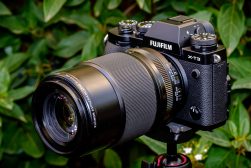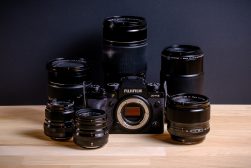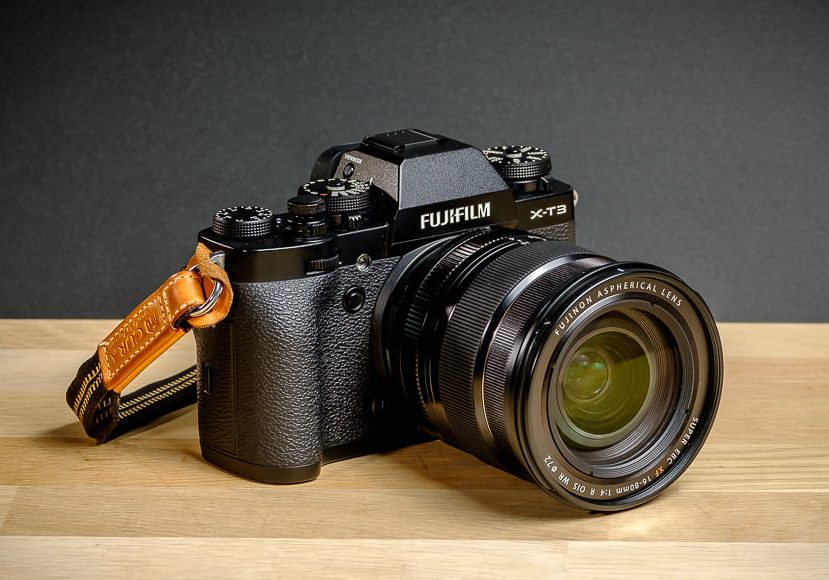
Fujifilm 16-80mm f/4 Review
The Fujifilm XF 16-80mm f/4 offers a solid build, snappy focus and versatile zoom range. Is it for you? Find out more in our in-depth review.
At the time of writing, the Fujifilm XF 16-80mm f/4 has only been around for a short time.
But with Covid19, social distancing, lockdowns and the like, it hasn’t had the kind of air-time a usual lens release would experience. At least not in my neck of the woods.
In a recent review of the Fujifilm XF 18-135mm, I suggested that the six-year-old lens should have an upgrade to fix some of the focusing and image quality issues. I’ll use the 18-135mm lens for a bit of comparison throughout this article.
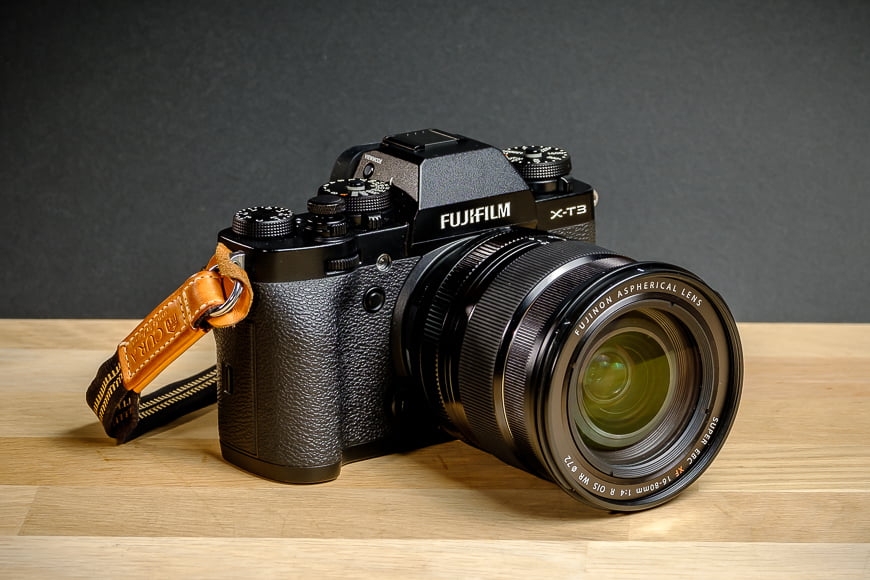
Compact and versatile lens that excels in any shooting situation.
And while Fujifilm has not listened to my suggestion of a Mark II – so rude! – perhaps the Fujifilm XF 16-80mm f/4 is, in fact, their attempt at delivering a similar all-in-one zoom that performs much better.
The only way to know for sure is to take a deep dive on all that the Fujifilm XF 16-80mm has to offer and see how it performs in key measurements.
Summary
The XF 16-80mm is a solid, weather-sealed yet lightweight lens. Despite some edge softness, the optical quality shines thanks to its snappy autofocus and excellent low light performance. Considering the versatile focal length, it’s a brilliant choice for a go-anywhere lens.
Fujifilm XF 16-80mm f/4 Specs
- Solid build but lightweight
- Weather sealed
- Flexible range ideal for travel
- Fast autofocus
- Corner softness evident
- Lens configuration: 16 elements in 12 groups (includes 3 aspherical elements and 1 ED aspherical element)
- Focal length: f=16-80mm(24-122mm)
- Angle of view: 83.2°-20.1°
- Aperture: f/4
- Aperture build: 9 (rounded diaphragm opening)
- Minimum focus distance: 35cm-∞
- Dimensions: 78.3mm x 88.9mm (Wide) / 131.5mm (Telephoto)
- Weight: 440g
- Filter thread: 72mm
- Weather-resistant: Yes
- Optical Image Stabilisation: Yes
Build & Ergonomics
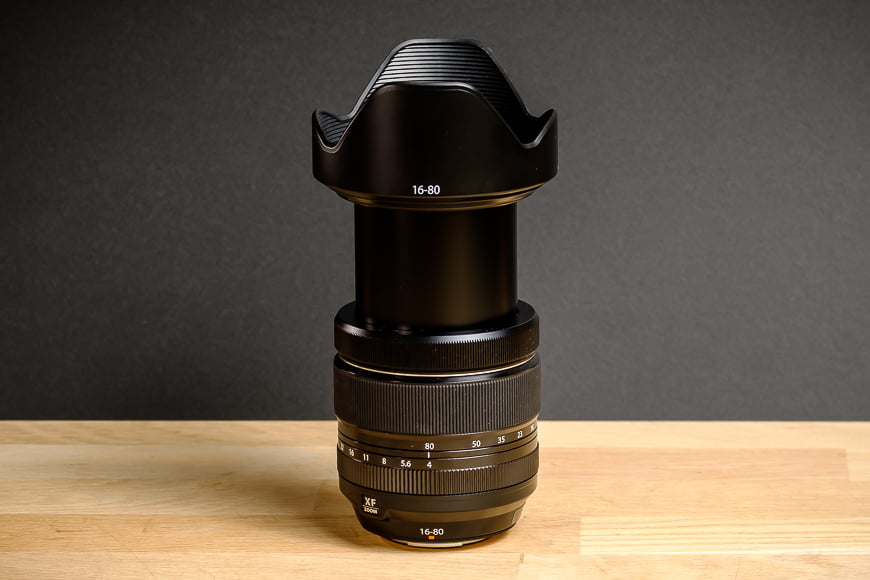
The Fujifilm XF 16-80mm f/4 is a solidly built and neat all-purpose zoom lens.
If you’ve been playing along at home and read some of my other Fujifilm lens reviews and guides, you’ll no doubt pick up on a theme. And that’s that Fujifilm lenses are built incredibly well.
Aside from having a barrel-like design, the Fujifilm XF 16-80mm f/4 has an all-metal body with no less than 10 points of weather sealing.
As a result, you can shoot in wet, dusty or cold conditions with temperatures as low as -10°C (14°F). (Note that you must have it paired with one of the Fuji flagship bodies to achieve this.)
While the lens is around the same size as the Fujifilm XF 18-135 when compressed, it’s a little bit lighter at 440g (0.97lb).
When paired with a camera such as the Fujifilm X-T3, it makes for a well balanced and comfortable kit. This is especially beneficial when you consider that, together, you now have an all-purpose setup for either photography or videography without the need to carry additional lenses.
When extended, the lens barrel extends smoothly out to 131.5mm (5.2″), and the petal-shaped lens hood adds another 40mm (1.6″) to the profile.
The 16-80mm focal length is an ideal range for a multipurpose lens. Such a range equates to 24-122mm in full-frame speak and is perfect for street, landscape and architecture at the wide end and sports, wildlife and portraits at the far end.
True to the typical retro styling of Fujifilm cameras and lenses, the XF 16-80mm features a metal ridged aperture ring with the values marked.
The focus ring has a finely ridged texture, and the zoom ring is broad with a rubber coating. Each is different enough from the others that you can shoot blind and find what you need. Further to this, each ring has an excellent level of travel and resistance.
Overall, it’s an exceptionally well-engineered zoom lens.
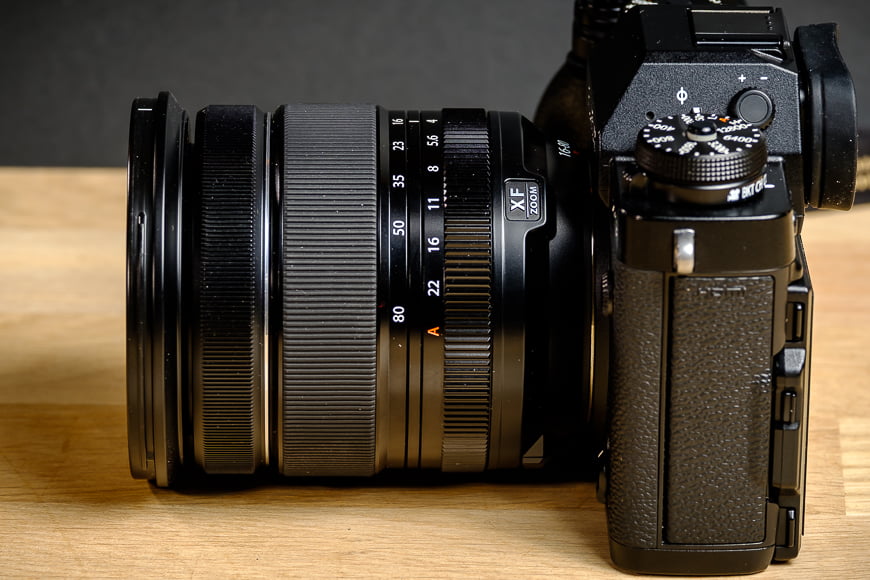
The Fujifilm XF 16-80mm f/4 balances well on any of the flagship Fuji X Series bodies.
On the inside, there’s a bunch of essential bits and pieces that make the magic happen. There are 16 elements in 12 groups that include no less than three aspherical lens elements.
Primarily, these are designed to correct distortion and reduce the aberrations that occur in every lens. Plus, there’s a single ED aspherical lens element or extra-low dispersion also intended to manage aberrations.
While the lens features Optical Image Stabilisation that delivers up to six stops of stabilisation, there’s no switch to activate this as you find on other Fujifilm lenses.
Generally speaking, you should always turn off OIS on a lens when you mount it to a fixed object such as a tripod. Lens stabilisation will look for any sign of shake or vibration and counter this.
If you don’t turn OIS off, the lens will try harder to look for and correct vibration and, in turn, cause actual vibration.
But without an OIS switch, how does the XF 16-80mm f/4 prevent this from occurring? The camera works in unison with the lens and when the camera detects that it’s sitting still, such as when it’s on a tripod, it turns the OIS off.
Focus Performance

Fujifilm XF 16-80mm f/4 | 48.5mm | 1/300 SS | ISO 400 | f/11 | Credit: Chris Upton
I was thoroughly impressed with the autofocus performance of this 16-80mm. Thankfully, it’s a massive jump in performance over the much older and much, much slower Fujifilm XF 18-135mm.
When shooting outdoors and in good light, the focus is super fast regardless of the zoom distance you’re shooting at. It quickly recognises and sticks to either a focus distance or subject without fail.
In lower light, I was surprised to find that it was just as fast and just as grabby – I only had a tiny bit of hunting when zoomed right out to 80mm in a very dark room. But I was just seeing how far I could push it and to give credit where credit is due; it’s impressive.
Another notable feature, and one that’s undoubtedly beneficial to videographers, is that the XF 16-80mm f/4 operates quickly and silently.
This is due to Fuji designing the lens to employ a focusing system built upon near-silent step motors.
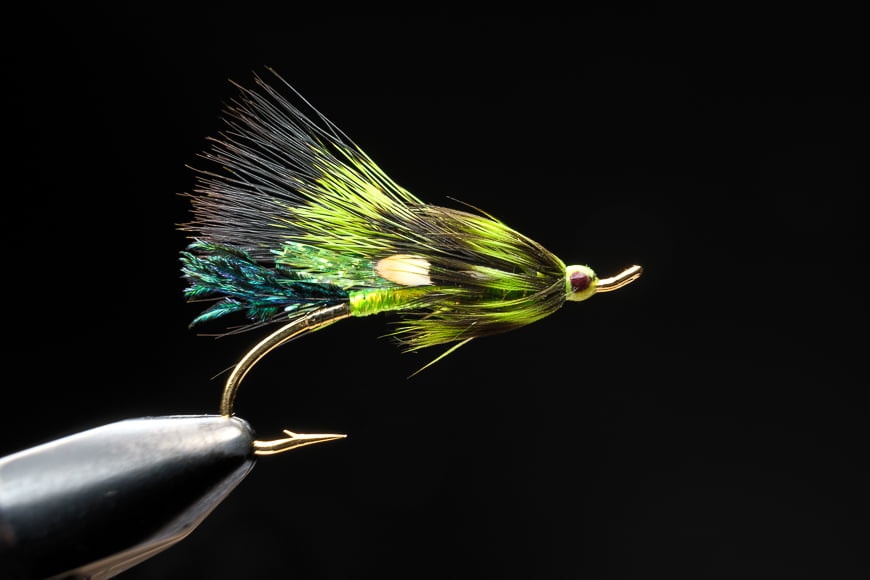
Fuji XF 16-80mm f/4 | Credit: Scott Grant
Focus performance always varies between users and genres. For example, those that primarily shoot sport or wildlife will require and expect a lens with blistering speeds. While the XF 16-80mm is not blistering, it’s certainly fast enough for the hobbyist or enthusiast.
For those that shoot landscape or food photography where the subjects are still and serene, you don’t need fast focus, but performance in low light is a must. Again, this lens will rise to these occasions and deliver performance and quality output.
Image Quality
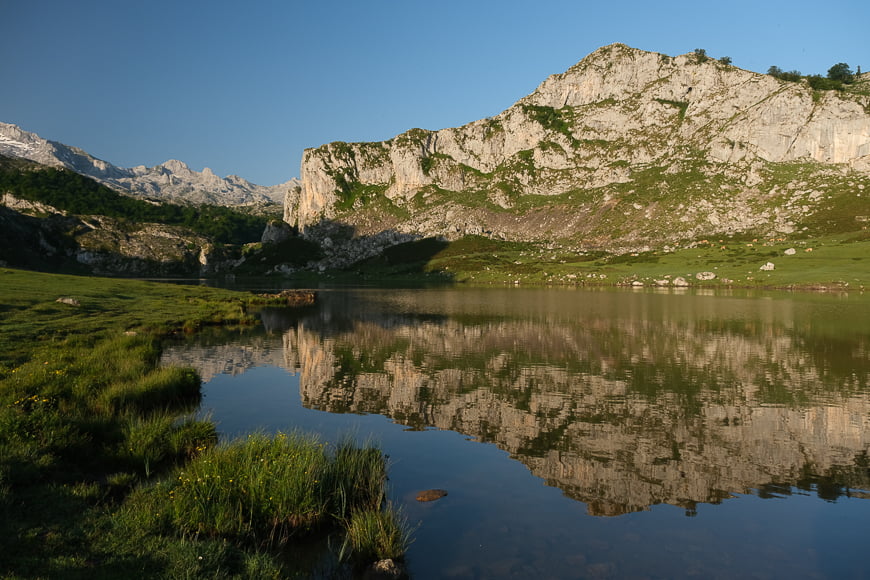
Fujifilm XF 16-80mm f/4 | 16mm | 1/125 SS | ISO 200 | f/5.6 | Credit: Rafa Parez
Images from the XF 16-80mm f/4 are clear and bright without any hint of distortion or aberration.
What’s more, background elements are well managed with creamy textures and excellent bokeh.
But, it’s not all smooth sailing.
When zoomed out to 80mm or pulled right into the wide end of 16mm, you get noticeably soft corners at f/4 with improvement by f/8 (however, still a little softness when you look for it).
As with most zoom lenses, you get the best optical outcomes around the middle of the range, and at 40mm, the sharpness improves considerably.
There’s no distortion or evidence of aberration through the focal range. And, thanks to a reasonably short minimal focal distance of 35cm (14″), you can get in super close to your subjects at either end of the focal range.
The result is dramatic shots with super soft backgrounds elements – this would be a perfect lens for food photographers that work in detail without background distraction.

XF 16-80mm f/4 | 16mm | 1/125 SS | ISO 500 | f/4 | Credit: Jens Burger
Thanks to the built-in OIS, the Fujifilm XF 16-80mm f/4 handles poor light exceptionally well. You can afford to stop down your aperture and drop ISO while shooting at slower shutter speeds. The results are proof that the OIS is doing exactly as promised and allowing additional stops dialled in for sharp images.
Open wide, even at f/4, subject separation is crisp with perfect falloff of out-of-focus elements.
Background blur is creamy without being distracting, and the bokeh is gorgeous with perfect balls, especially with introduced background lighting.
This is thanks to the use of nine rounded blades in the diaphragm as opposed to only seven as seen in the XF 18-135mm.
Value for Money
When you come across a piece of camera gear that not only meets but exceeds performance expectations, you’re almost certainly expecting a steep price-tag. This is especially true when the item offers such a compelling package as the XF 16-80mm f/4.
This lens presents you with the option to buy one bit of gear to handle most everyday shooting scenarios.
It makes sense as a perfect travel lens when paired with one of the Fujifilm X-Series camera bodies. Finally, the 16-80mm delivers fantastic image quality despite a few instances of corner softness.
With all of this in mind, it would be natural to anticipate some level of bill shock. But the surprise bill at the end of the fancy dinner doesn’t shock you with this lens.
The XF 16-80mm f/4 retails for under US$800, making it exceptional value for money when you consider all it has to offer.
As a result, it’s a lens that sits at the top of my bucket list.
Fujifilm XF 16-80mm f/4 Review | Conclusion
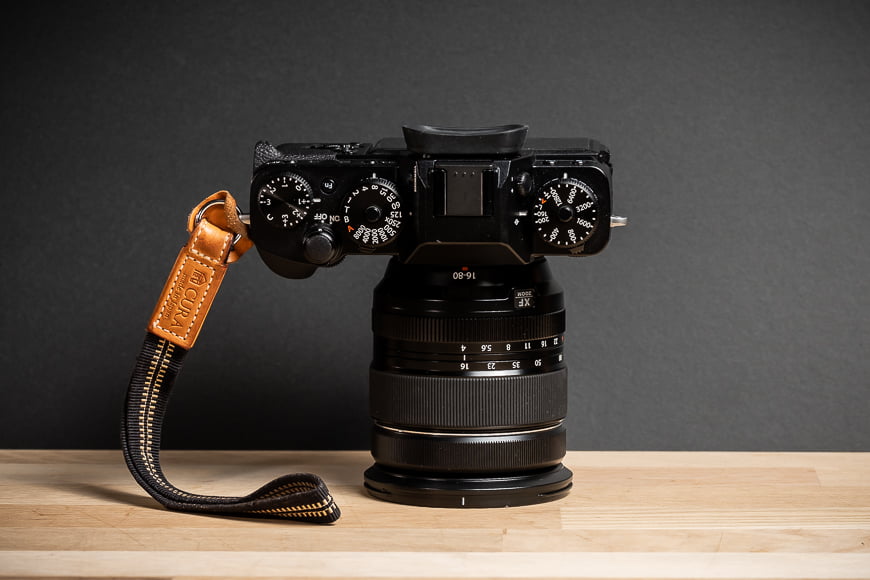
The Fujifilm XF 16-80 f/4 is a brilliant all-in-one zoom lens perfect for travel.
The most significant sticking point with the Fujifilm XF 16-80 f/4 is the corner softness experienced at the wide and zoom end of the range.
If you’re shooting in the middle of the range, then it’s not a problem – but you should probably buy a 50mm prime if that’s the case.
While you achieve better outcomes with a narrower aperture, that comes with its issues – less light, less subject separation, etc.
For most people, the corner softness is not going to be that big an issue and, to be honest, it wouldn’t stop me from purchasing this otherwise fantastic lens. But, it wouldn’t be a fair review if I didn’t point it out.
Plus, if you want a lens that you can use for both stills and video work – Fuji cameras produce exceptional video quality – then this is for you.
The flexible focal range, minimum focal distance, autofocus speed and overall image quality come together to deliver an ideal lens.
If you’re a prime shooter but want an all-purpose lens for the times you need one, this is without a doubt the best choice. If you’re heading away on travels but don’t want to carry a bag of primes, again, you couldn’t do much better at capturing those memorable experiences.
Or, if you’re a creative still or video type, the Fujifilm XF 16-80mm f/4 is hard to pass up in terms of overall performance and value.

Compact and versatile lens that excels in any shooting situation.







